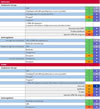Background
Acute coronary syndromes (ACS) are frequent and life-threatening episodes of acute myocardial ischemia increasing in our days. The majority are caused by a sudden rupture of a coronary artery plaque generating a downstream activation of platelets, coagulation cascade and thrombus formation (1).
After this initial event, activated platelets adhere to the endothelium and start to aggregate with each other, creating an expanded response (2). Both platelet aggregation and coagulation activation create a severe impairment of the coronary blood flow, resulting in the clinical manifestations of both acute myocardial infarction (AMI) and non-ST segment elevation acute coronary syndrome (NSTEACS).
Coronary catheterisation and stent implantation are the state-of-the-art treatment for patients with ACS of moderate to high risk. The aim of this procedure is to restore coronary blood flow to the myocardial ischemic heart. Ischemic and hemorrhagic complications are life-threatening and limit high mortality (3,4).
I - Thrombin inhibitors: Bivalirudin
Activated thrombin is one of the key steps causing ACS due to its potent effect over platelet activation. Aspirin plus clopidogrel/prasugrel are mandatory in the treatment of patients with ACS in order to avoid platelet aggregation and thrombus formation (1,2). Anticoagulant treatment for ACS has recently changed since bivalirudin emerged and has demonstrated clinical benefit over classic non-fractioned heparin/enoxaparin treatment.
In the recent history, several studies have achieved improved results combining many of these agents. Enoxaparin showed better outcomes in ACS than heparin (Sinergy Trial) (5). Abciximab gain a lot of interest due to its effect reducing ischemic events after ACS (6). Nevertheless, major bleeding became an increasing concern for cardiologists and interventional cardiologists, especially after Eikelboom et al (7) demonstrated an increased mortality for patients with haemorrhagic complications.
Bivalirudin is a hirudin analogue with a potent and reversible inhibition of thrombin (IIa factor) also inhibiting thrombin in developed clots. Moreover, its action starts 2 minutes after the bolus injection and lasts only 25 minutes after withdrawal (if normal creatinine clearance).
II - Clinical applications
Current treatment of ACS includes several antiplatelet agents (ASA, clopidogrel, prasugrel), potent antithrombotic agents inhibiting GP IIb/IIIa receptor (abciximab, tirofiban, eptifibatide) and anticoagulant therapy (non-fractioned heparin, enoxaparin and bivalirudin) (see Figure 1).
A) Non-ST elevation acute coronary syndromes (NSTEACS)
ACUITY trial8 enrolling 13819 patients from 17 different countries compared bivalirudin vs NFH + GPIIbIIIa inhibitors 1 month after ACS, showing a similar antithrombotic effect (ischemic composite of death, MI or unexpected revascularisation: 7,8% vs 7,3%, respectively, RR 1,08 [CI 95%: 0,93-1,24]) and markedly less major bleeding (see Figure 2) (3% vs 5,7%, respectively, RR 0,53 [CI 95%: 0,43-0,65]), resulting in a net clinical benefit (10,1% vs 11,7%, respectively, RR 0,86 [CI 95%: 0,77-0,97]).
At 1 year, mortality rates were higher in patients with myocardial infarction and bleeding complications (mean: 28%), followed by patients with bleeding complications (12,5%) and by those with myocardial infarction with no bleeding complications (8,6%). Moreover, lowest mortality was observed in patients without evidence of myocardial infarction and no bleeding complications (3,4%).
B) Acute myocardial infarction (AMI)
HORIZONS-AMI Trial conducted by Stone GW et al (9) enrolled 3602 patients with STEAMI undergoing a primary PCI strategy and were randomised to receive heparin + GPIIbIIIa inhibitors or bivalirudin alone. Patients receiving bivalirudin alone experienced less bleeding complications (8,4% vs 5% p< 0,0001) and similar major adverse cardiovascular events (5,4% vs 5,5%, p= 0,99) resulting in less mortality from cardiac and non-cardiac causes (1,8% vs 2,9%, p= 0,029) and a significant net clinical benefit (9,3% vs 12,2%, p= 0,006). In addition, patients treated with bivalirudin alone developed significantly less thrombocytopenia.
Results at 3 years have been recently presented in TCT 2010 Congress (Washington DC, USA, September 2010) showing global mortality benefit in patients receiving bivalirudin alone vs patients receiving heparin + GPIIbIIIa inhibitors (5,9% vs 7,7%, p= 0,03). Furthermore, cardiac mortality significantly decreased (2,9% vs 5,1%, p< 0,001), re-infarction rates decreased (6,2% vs 8,2%, p= 0,04) in patients with STEAMI receiving bivalirudin. Indeed, major bleeding rates decreased dramatically in those receiving bivalirudin (6,9% vs 10,5%, p< 0,001) resulting in mortality benefit previously described. Besides, best survival rates were obtained in patients receiving bivalirudin and with Taxus® (paclitaxel) stents vs bare metal stents.
An increasing concern has been raised due to the high rates of definite and/or probable stent thrombosis observed. Investigators from HORIZONS-AMI have presented data at 3 years confirming results from other drug eluting stents (DES) implantation groups. Bivalirudin patients experimented 1,5% stent thrombosis in the first 24 hours after stent implantation vs 0,3% stent thrombosis in patients receiving heparin + GPIIbIIIa inhibitors, raising serious concern in both interventional and clinical cardiologists. Nevertheless, stent thrombosis rates tend to equalise (bivalirudin 3% vs 2,2%, p> 0,05 at 1 year; 4,5% vs 5,1%, p> 0,05 at 3 years) but are the target of further investigation nowadays.

Figure 1. Practical guidelines: antithrombotic treatment options in myocardial revascularisation (10).
Figure 2. Major bleeding definition (ACUITY8 scale).
- Intracranial
- Intraocular
- Retroperitoneal
- Access site - requiring intervention/surgery
- hematoma =5 cm - Hgb ß =3 g/dL with overt source
- Hgb ß =4 g/dL w/o overt source
- Blood transfusion
- Reoperation for bleed
Conclusion:
- Bivalirudin is a potent thrombin inhibitor with rapid and reversible action that has shown decreased mortality in patients with ACS undergoing PCI or moderate to high-risk NSTEACS due to reduce bleeding rates
- ACUITY and HORIZONS-AMI studies demonstrated net clinical benefit for patients receiving bivalirudin compared with those receiving heparin + GPIIbIIIa inhibitors (less bleeding complications). Both studies emphasized the importance of an appropriate antiplatelet treatment (aspirin + clopidogrel/prasugrel with loading doses) for ACS patients receiving bivalirudin.
- Bivalirudin treatment should be considered in those with moderate/high risk bleeding complications: age > 65 years, diabetes mellitus, renal function impairment, women, hypertension, previous CVA, intra-aortic counterpulsation balloon.



 Our mission: To reduce the burden of cardiovascular disease.
Our mission: To reduce the burden of cardiovascular disease.